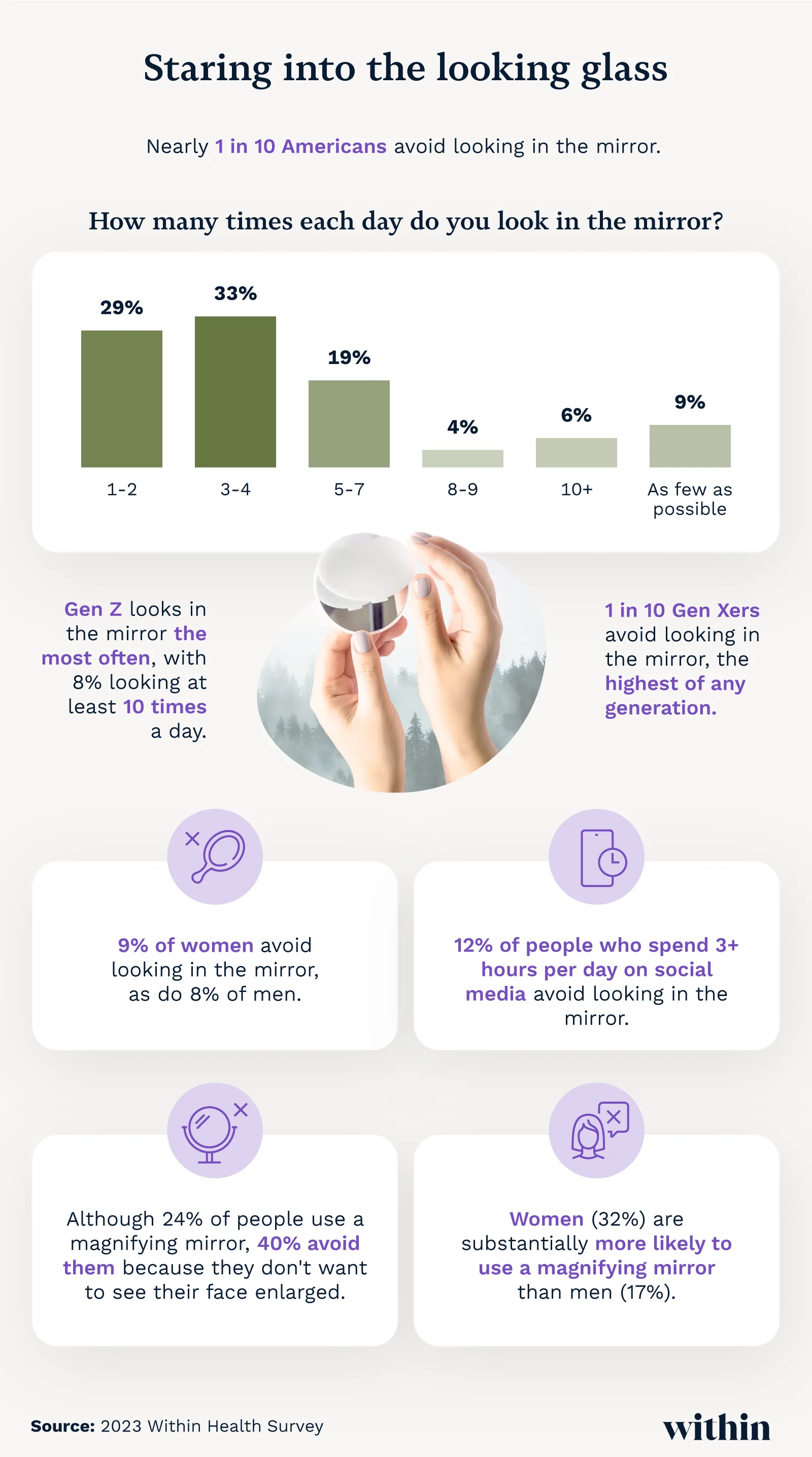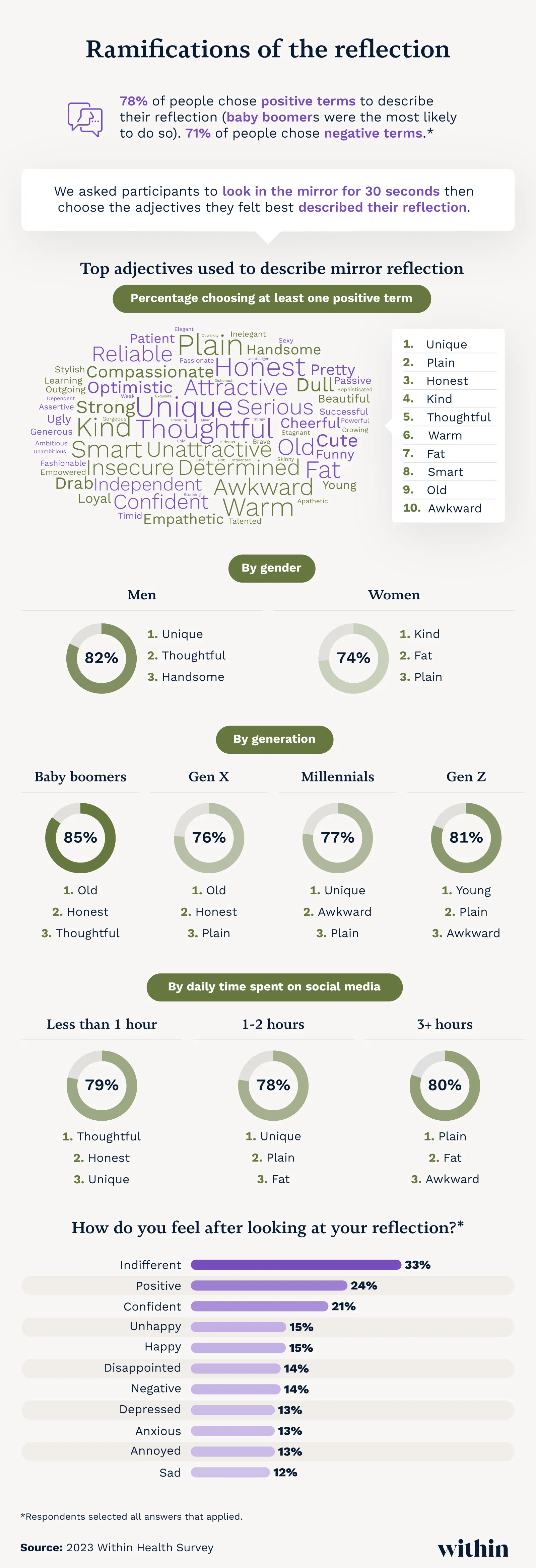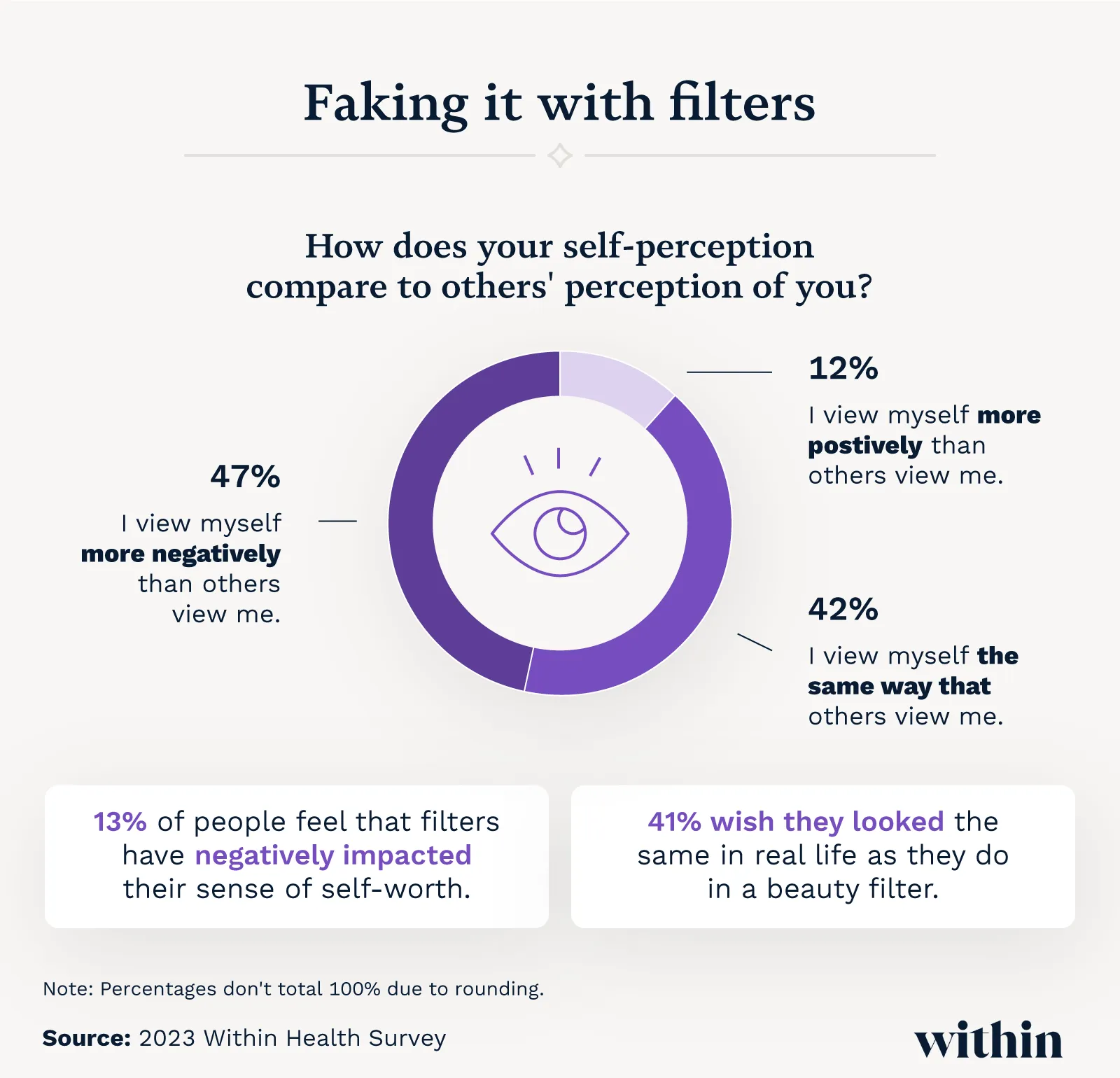
How does it feel to look in the mirror? We asked more than 1,000 Americans to share their sentiments and uncovered how often they check themselves out, which of their features they look at most, and if their time spent on social media might play a role. We also had them share how they’d describe themselves after gazing at their reflections. Let’s see how Americans perceive their appearance and feel about themselves.
First, we’ll look into who’s checking themselves in the mirror the most often and who prefers avoiding it altogether.

Our youngest respondents, Gen Zers, reported looking in the mirror more than any other generation we surveyed. And while most people said they look in the mirror just 1-4 times each day (29% said 1-2 times and 33% said 3-4), 7% of women said the number was upwards of 10 or more. They were also more likely than men to use a magnifying mirror (32% compared to 17%).
Self-consciousness might lead some people to avoid looking in the mirror altogether. According to our survey results, nearly 1 in 10 Americans avoid it. But although social media can make users more self-conscious by encouraging them to compare themselves to others, we didn’t see a direct correlation between the time people spent on social media and whether or not they avoided mirrors.1 Here are the percentages who said they avoid looking in the mirror by how much time they spend on social media daily:
But as we’ll illustrate in the next section, there was a much closer correlation between social media time and what people focus on when gazing into mirrors.
To find out what draws people to (or deters them from) using mirrors, we asked respondents about their favorite and least favorite personal features.

Fixing hairstyles might be the most common reason people check the mirror since most of our respondents said their hair is the feature they notice most when they look at their reflection. Hair was also one of the features that gave them the most self-confidence.2 Overall, the top three confidence-boosting features among respondents were:
Respondents also shared that their biggest insecurities were their:
Women have spent more time than men focused on features that make them feel insecure, by a full two minutes per day. We also saw some generational differences here:
But age and gender weren’t the only comparisons that showed a difference. Here’s how long respondents spent examining their insecurity-inducing features in the mirror based on the time they spent on social media each day:
While we didn’t notice consistencies in social media and mirror times overall in the first part of our study, this data shows that social media use might lead to more time thinking about physical features that cause insecurities.
Next, we asked respondents what they see when they look in the mirror.

After looking in the mirror for 30 seconds, the top 10 adjectives people used to describe themselves based on their appearance were:
Baby boomers were the most likely to describe their reflection in positive terms. Self-talk matters and that includes the thoughts we think when we see ourselves, so it’s concerning that only some of the descriptive words above were positive.4 We also noticed that when describing themselves positively, they generally didn’t use words about their appearance. Instead, they would more often use negative words to talk about it.
But some people’s answers included positive self-describing words like:
We also determined that some descriptive terms were more commonly used by people with certain features. Here are the top three by respondents’ hair and eye color:
Black hair
Blonde hair
Brown hair
Blue eyes
Brown eyes
Green eyes
Hazel eyes
Our research has only begun to paint a picture of certain demographics’ mirror-use tendencies. Let’s go deeper and see how respondents described their relationship with the mirror as well as the camera.

Some of us have warped self-perceptions based on what we see in the mirror.5 But of those we surveyed who said they have a “positive” relationship with the mirror, most were men (34% compared to 27% of women). Overall, 31% of people have a positive relationship with the mirror.
People generally seemed to feel the same about their relationship with the mirror regardless of how much time they spent on social media. Of those who spent under one hour and up to two hours on social media, 30% of each reported a positive relationship. That only jumped seven percentage points among those who spent three hours or more on social media.
Social media is a world of selfies, and we found that 33% of women took selfies regularly compared to only 29% of men. Selfies were also more common among Gen Z (40%) than any other generation.
Like much of what we’ve seen so far, more time on social media didn’t seem to strongly impact how people have felt about having their photo taken. Here are the percentages of respondents who expressed a positive relationship with the camera based on the time they spent on social media each day:
Our generational comparison showed only slight differences, with millennials being the most likely to express a positive relationship with the camera:
Could social media’s misleading image filters play a role in people’s self-worth and how they feel about their looks?6

TikTok’s “bold glamour” beauty filter edits people’s facial features on film, often making them appear very different from how they look in real life. The 1 in 10 respondents who have tried it said it made them feel:
Although most of them were amused by how they looked under the filter, 13% of respondents shared that social media filters have negatively impacted self-worth. It’s no wonder that almost half also said they’re probably harder on themselves than others are. Among this group, 41% wished they looked the same in real life as they do in a beauty filter.
It’s too easy these days to set impossible self-standards in this age of unrealistic photo filters. But while the time spent scrolling through social media feeds doesn’t appear to have people avoiding the mirror, it may lead them to be more critical of their physical appearances. And too often, people describe their physical features with negative self-talk.
What we tell ourselves makes a big difference in how we feel and move through the world. So, instead of picking ourselves apart in the mirror, let’s focus on our favorite features that boost our confidence. That’s a much better way to spend those 7-10 minutes each day.
We talked to 1,007 Americans to see how they felt about their reflections when they looked in the mirror. Among them, 49% were women, 50% were men, and 1% were nonbinary or nonconforming. Additionally, 12% were baby boomers, 29% were Gen X, 51% were millennials, and 8% were Gen Z. For analysis using the amount of time people spent on social media, 42% used it for less than one hour a day, 47% used it for one to two hours a day, and 10% used it for three or more hours a day. When looking at people by eye color, 25% had blue eyes, 47% had brown eyes, 12% had green eyes, and 16% had hazel eyes. Finally, when looking at people by hair color, 21% had black hair, 13% had blonde hair, 55% had brown hair, and 11% had hair of another color.
Within Health’s team of specialists supports people suffering from eating disorders, and virtual treatment means getting care from the comfort of home.
If you know someone who might benefit from our research, please feel free to share it for any non-commercial purpose. We just ask that you include a link to this page.






Within is committed to providing accurate and up-to-date information on eating disorders and mental health.
Read our editorial policy.